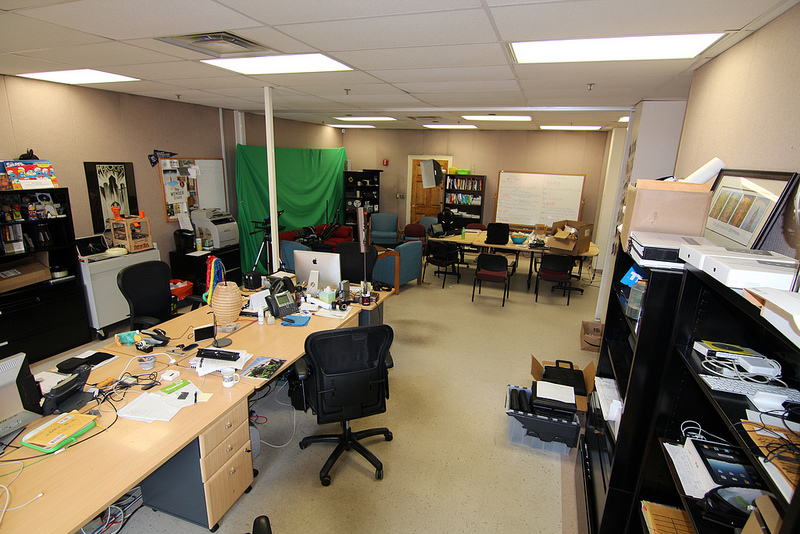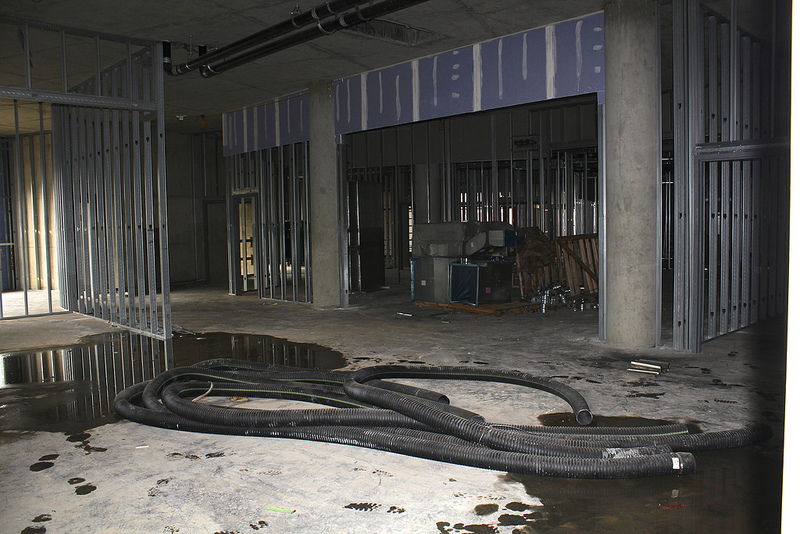Last week, Jim and I presented in Richmond at Open VCU about the experience of teaching #ds106. It was a lot of fun — but talking about #ds106 with Jim is always a lot of fun. We prepared a different kind of presentation, in which we examined the course/community through three different lenses of openness, and we used it as an opportunity to circle through a number of ideas while looking through those various lenses. You can find the presentation here, though I’m told the audio leaves a bit to be desired. We’ll just have to do it again at some point. 🙂
During the Q&A Jeff Nugent of VCU’s Center for Teaching Excellence asked a question about how other schools can push forward with the “community design process” that we described as being so critical to the success of #ds106. It’s a good question, and it echoes questions I hear a lot when I speak to others about the successes that we’ve enjoyed at UMW with our work in DTLT. Jeff’s question was specific to a particular aspect of #ds106 that we had brought up in the presentation — the notion that the “course” wasn’t designed by a single person nor was the design process even led by a single person — and my response was what I often say to similar questions which is that a) we’ve enjoyed tremendous success in DTLT over the last decade with projects we’ve worked on and developed, and b) I’m incredibly proud of that work we’ve done, but c) I can honestly say we absolutely never sit down and engineer our project design. Our approach is organic and messy — the projects that have become huge successes have all percolated up naturally through our community, our shared interests, and our individual passions. I spoke to this a bit in my recent post about organic project development.
But Jeff’s question, more generally got me thinking about the many times over the years when people have asked me how we do it at UMW. “What’s in the water in Fredericksburg?” they’ll ask. I’ve given lots of answers to these kinds of questions: we have an incredible faculty to work with at UMW who are willing to take risks with us (VERY true); we’ve been lucky to fly under the radar at times, allowing us to experiment and play in ways that are sometimes unusual for groups like ours (also true); we’ve had, at various times, VERY supportive administrators who have given us space and trusted us (also true); we believe in investing in our people not in the latest (usually expensive) technology (true, true true). The list could go on.
But as Jim and I were driving home last Friday, we were talking about question of “what’s allowed us to do the great stuff we’ve done?” a bit more, and I realized that there is one aspect of DTLT that we rarely talk about explicitly but that, upon reflection, may be a crucial, critical component of our success.
The best way for me to start this discussion off is with a picture:

That’s a picture of the space that DTLT occupies. And, as you can see from the picture, we truly occupy it. It’s a bit of a mess. But, most importantly, in the center of the picture, you can see where we all sit. That’s my chair right in the middle. Tim sits across from me. Jim sits at the end of the desks. Andy’s space is cut off next to Tim. At the time this picture was taken, the final desk in the bottom-left hand corner was unoccupied, but now it’s where Ryan sits.
We all sit there, everyday, with our desks jammed up against each other. We do not have separate, individual offices that we can escape to. When we need a bit of quiet, we retreat to the Library or elsewhere on campus.
There is almost constant conversation, and, as a result, there is almost constant collaboration. It’s an incredibly dynamic, intense way to work. We see each other at our best and at our worst. We have argued around these desks; we have each at one point or another needed to leave the room because we needed to take a breather. It can be a struggle to share your space with four other people, day in and day out. There are times when I feel like the noise and activity in this space will drive me crazy. We subject ourselves to each others’ scrutiny and observation almost constantly.
For many people the kind of environment I’m describing probably sounds like a particularly bad circle of work hell. I wouldn’t trade it for the world. I have absolutely no doubt that if we each worked in a separate office (even if those offices were located next to each other) we wouldn’t be where we are today, with projects like UMW Blogs, ds106, and Domain of One’s Own as part of our collaborative portfolio.
I’m pretty sure we owe this setup to Jerry Slezak, our former colleague in DTLT, who suggested when we moved into this office from our distributed (private) offices around campus, that we needed to try a “bullpen” approach. We could have set up separate cubicles in the space, but I’m really glad we didn’t. I don’t think we’d have the same dynamic.
Moving into this space from private offices was a huge modification to our work practices (that happened in 2006, eight years ago this summer). And when I describe my work environment to other people they often tell me they could never work that way. I can understand that, since it was an adjustment for all of us.
Working in a collaborative space like this requires a lot of us: trust, humility, patience, to name a few. But the payoff has been so tremendous that I can’t imagine ever changing this model. In six months or so we’re moving into the University’s new IT Convergence Center, and we’re taking the bullpen environment with us.

It’s difficult to measure the impact of the workspace of DTLT. I can only understand it when I think about the alternative: separate, isolated offices; meeting after meeting needing to be scheduled to discuss projects or collaborations; little or no organic sharing and conversation. I’ve worked in that kind of isolated, private space, and now I’ve also worked in this kind of messy, public space. The latter affords us constant opportunities to bounce ideas off each other, to share what we’re working on right now, to seek advice and feedback, to laugh at each other’s jokes (and each other), to learn more about who we are as people, to become a kind of family. Out of that we’ve learned how to build things together, how to fix things together, how to depend on each other, how to trust each other, and how to take care of each other. I think that’s the real magic of DTLT.


RT @mburtis: On my blog: A Tribute to the Bullpen: http://t.co/AFb4rr1G6v
Great post by @mburtis on one of the best kept secrets to DTLT success (and a true reason I love my job) http://t.co/QdMWFBVQJi
RT @timmmmyboy: Great post by @mburtis on one of the best kept secrets to DTLT success (and a true reason I love my job) http://t.co/QdMWFB…
Yes! This is really one of the secret ingredients to the DTLT magic. You describe the dynamics of the office so well. It is messy and chaotic, but it is where the best stuff comes from.
Getting the opportunity as a student to be in this environment really changed my view on work and collaboration.
Here’s to the bullpen!
.@mburtis offers brilliant insight to UMW’s innovative approach to edtech-it’s all about people in space! http://t.co/1Nwxvbvw1u #dtlt4life
How can I not retweet this. Beautiful. RT @mburtis: On my blog: A Tribute to the Bullpen: http://t.co/yAqpdiStfK
RT @mburtis: On my blog: A Tribute to the Bullpen: http://t.co/AFb4rr1G6v
“@mburtis: On my blog: A Tribute to the Bullpen: http://t.co/0dR7qEp9AS” Look on DTLT’s works, ye isolated classroom teachers, and despair.
RT @timmmmyboy: Great post by @mburtis on one of the best kept secrets to DTLT success (and a true reason I love my job) http://t.co/QdMWFB…
RT @timmmmyboy: Great post by @mburtis on one of the best kept secrets to DTLT success (and a true reason I love my job) http://t.co/QdMWFB…
RT @mburtis: On my blog: A Tribute to the Bullpen: http://t.co/AFb4rr1G6v
Having spent a stint in the bullpen, I have to say this setup is integral, more so than the water. It’s that thing where DTLT becomes gets all the benefits and some dysfunction of a family, because you work together.
The room makes a statement when people enter. It’s like walking onto the set of a studio. Some of my favorite moments were watching what happened when faculty/guests walked in to the sound of the Makerbot, and they immediately asked questions of it and the bowl of objects.
All of this says to someone entering, this is a place to ask, to wonder. Someone buy Jerry a cheeseburger, his bullpen idea is almost like the un-named clutch player on the team.
Next time you are in town Alan, we can get a cheeseburger and watch and O’s game.
I’m working on it!
Some related thoughts on Jon Becker’s related post
http://www.jonbecker.net/open-is-as-open-does/
How does UMW’s DTLT manage to be so creative? @mburtis explains: http://t.co/x4eqDSFc9a
RT @jmcclurken: How does UMW’s DTLT manage to be so creative? @mburtis explains: http://t.co/x4eqDSFc9a
RT @jmcclurken: How does UMW’s DTLT manage to be so creative? @mburtis explains: http://t.co/x4eqDSFc9a
Trying not to be jealous, and failing:
http://t.co/JpaDHJwx0C
One way in which we are succeeding in keeping up with the Groomses/Burtises/Rushes/Owenses/Brazelleses — we love our open space as well. It’s not as well appointed as yours by a long shot, but we maintain the same thing, that it’s a big part of what keeps us high-functioning misfits rather than just disgruntled slackers. There’s been talk from time to time about changing our location, but we have managed to make a good case for our layout needing to stay roughly the same. I felt some of the same feelings when I visited y’alls space that I have in our own.
RT @jmcclurken: How does UMW’s DTLT manage to be so creative? @mburtis explains: http://t.co/x4eqDSFc9a
I must agree that the bullpen did work out for us – but that is because we all made it work for us. We were all pretty committed to it, and all went in knowing it would be hard, but that the benefits could be great. I guess saying “it could be great” ends up being a huge understatement.
But it was that perfect combination of things – the right place and the right people that made it work, and still continue to do some of the most interesting EdTech work out there.
I miss my daily seat at the table in that room working on those projects, debating, arguing, laughing. But mostly I miss the people that are DTLT. They were, and still are, family.